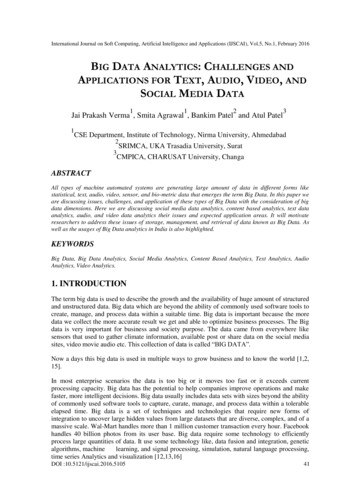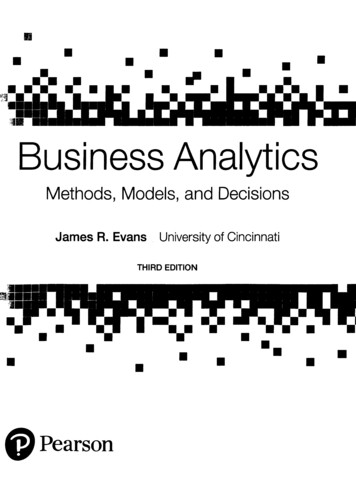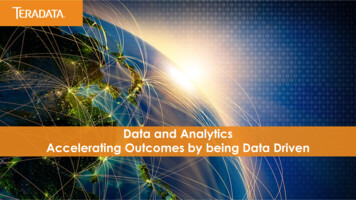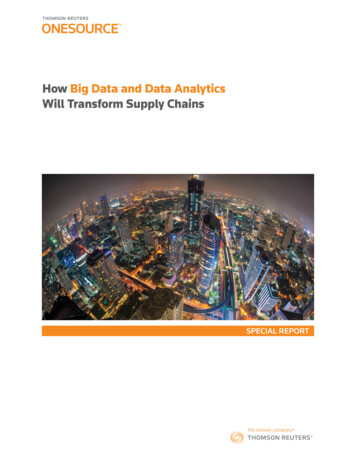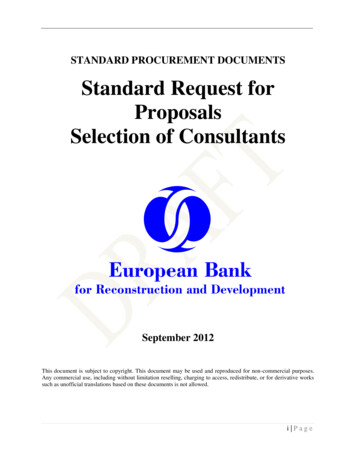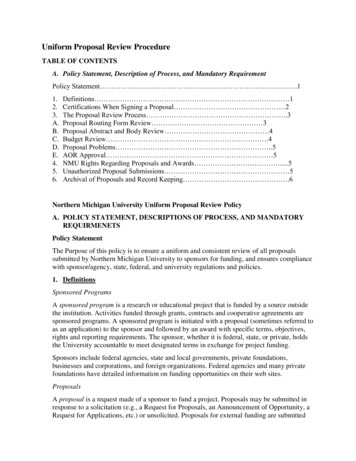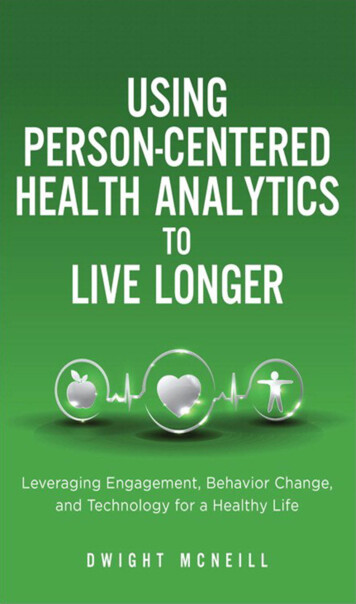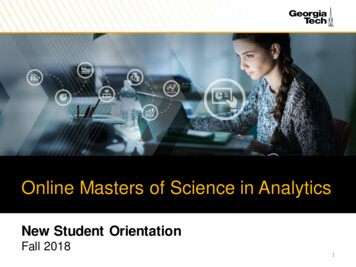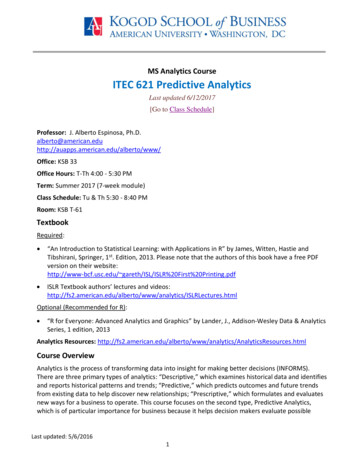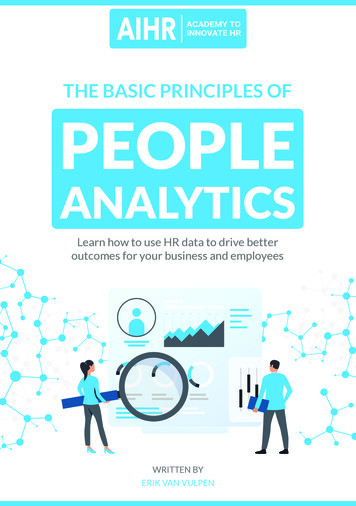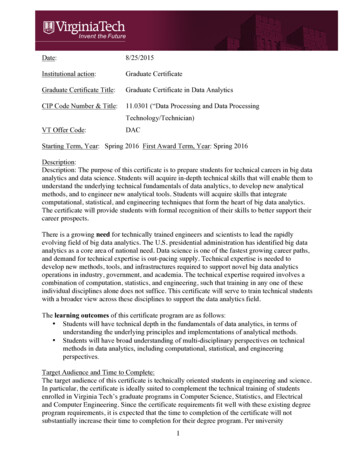
Transcription
Date:8/25/2015Institutional action:Graduate CertificateGraduate Certificate Title:Graduate Certificate in Data AnalyticsCIP Code Number & Title:11.0301 (“Data Processing and Data ProcessingTechnology/Technician)VT Offer Code:DACStarting Term, Year: Spring 2016 First Award Term, Year: Spring 2016Description:Description: The purpose of this certificate is to prepare students for technical careers in big dataanalytics and data science. Students will acquire in-depth technical skills that will enable them tounderstand the underlying technical fundamentals of data analytics, to develop new analyticalmethods, and to engineer new analytical tools. Students will acquire skills that integratecomputational, statistical, and engineering techniques that form the heart of big data analytics.The certificate will provide students with formal recognition of their skills to better support theircareer prospects.There is a growing need for technically trained engineers and scientists to lead the rapidlyevolving field of big data analytics. The U.S. presidential administration has identified big dataanalytics as a core area of national need. Data science is one of the fastest growing career paths,and demand for technical expertise is out-pacing supply. Technical expertise is needed todevelop new methods, tools, and infrastructures required to support novel big data analyticsoperations in industry, government, and academia. The technical expertise required involves acombination of computation, statistics, and engineering, such that training in any one of theseindividual disciplines alone does not suffice. This certificate will serve to train technical studentswith a broader view across these disciplines to support the data analytics field.The learning outcomes of this certificate program are as follows: Students will have technical depth in the fundamentals of data analytics, in terms ofunderstanding the underlying principles and implementations of analytical methods. Students will have broad understanding of multi-disciplinary perspectives on technicalmethods in data analytics, including computational, statistical, and engineeringperspectives.Target Audience and Time to Complete:The target audience of this certificate is technically oriented students in engineering and science.In particular, the certificate is ideally suited to complement the technical training of studentsenrolled in Virginia Tech’s graduate programs in Computer Science, Statistics, and Electricaland Computer Engineering. Since the certificate requirements fit well with these existing degreeprogram requirements, it is expected that the time to completion of the certificate will notsubstantially increase their time to completion for their degree program. Per university1
requirements, at most 6 of the required 12 credits for the certificate can be double countedtowards their degree program, meaning that students will need to take at least two additionalcourses beyond their existing degree requirements. However, students in other graduateprograms at VT are not precluded. The estimated time to completion for students in other degreeprograms and for non-degree seeking participants is one year.Admission:Admission to the Graduate School and completing a Graduate Certificate Application arerequired for both degree- and non-degree seeking students.Degree-seeking applicants:The Graduate School requires completion of a bachelor’s degree from an accredited institutionwith a GPA of 3.0 or better for admission to Certificate Status. Applicants with anundergraduate GPA 3.0 may qualify for Commonwealth Campus admission. Studentspursuing a degree and a certificate simultaneously are classified within their degree program.Certificate credits may be used to meet degree requirements if they are appropriate for inclusionon the degree Plan of Study.Non-degree seeking applicants:A qualified person who wishes to enter Virginia Tech to obtain a graduate certificate, withoutbeing enrolled in a degree program, may apply for graduate admission to Graduate Certificatestatus. Such applicants submit an Application for Admission and a Graduate CertificateApplication ficate application.pdf, and mustmeet the following criteria: GPA of 3.0 for admission for the last half of the credits earned for the undergraduate(bachelors) degree* official transcripts must be submitted. academic background meets the requirements of the admitting academic unit. International applicants must submit scores from the Test of English as a ForeignLanguage (TOEFL) or the International English Language Testing System (IELTS). Aminimum TOEFL score of 550 paper-based (PBT) or 80 internet-based test (iBT) isrequired for consideration of the application. On the iBT, subscores of at least 20 on eachsubtest (Listening, Speaking, Reading, and Writing) are required for admission. Aminimum IELTS score of 6.5 is required for admission. Some departments have higherTOEFL or IELTS score requirements than those set by the Graduate School.Curriculum Requirements and Descriptions:Number of Credit Hours:Students should complete at least 2 courses from the core list (see below) and 2 courses from theelective list, for a total of 12 credits. For all students, courses taken must span all threedepartments; Computer Science, Statistics and Electrical and Computer Engineering. All2
courses must be graded A-F, and students must attain a minimum 3.0 GPA in the designatedcourses. Transfer credits are not permitted.Core Courses: (Choose 2)CS/STAT 5525 Data Analytics IBasic techniques in data analytics including the preparation and manipulation of data for analysisand the creation of data files from multiple and dissimilar sources. The data mining andknowledge discovery process. Overview of data mining algorithms in classification, clustering,association analysis, probabilistic modeling, and matrix decompositions. Detailed study ofclassification methods including tree-based methods, Bayesian methods, logistic regression,ensemble, bagging and boosting methods, neural network methods, use of support vectors andBayesian networks. Detailed study of clustering methods including k-means, hierarchical andself-organizing map methods. Prerequisites: none. (3H, 3C)CS/STAT 5526 Data Analytics IITechniques in unsupervised and visualized learning in high dimension spaces. Theoretical,probabilistic, and applied aspects of data analytics. Methods include generalized linear models inhigh dimensional spaces, regularization, lasso and related methods, principal componentregression (pca), tree methods, and random forests. Clustering methods including k-means,hierarchical clustering, biclustering, and model-based clustering will be throughly examined.Distance-based learning methods include multi dimensional scaling, the self organizing map,graphical/network models, and isomap. Supervised learning will consist of discriminantanalyses, supervised pca, support vector machines, and kernel methods. Prerequisites: CS/STAT5525. (3H, 3C)CS 5824/ECE 5424G: Advanced Machine LearningAlgorithms and principles involved in machine learning; focus on perception problems arising incomputer vision, natural language processing and robotics; fundamentals of representinguncertainty, learning from data, supervised learning, ensemble methods, unsupervised learning,structured models, learning theory and reinforcement learning; design and analysis of machineperception systems; design and implementation of a technical project applied to real-worlddatasets (images, text, robotics). Prerequisites: none. (3H, 3C)Restricted Elective Courses: (Choose 2)CS 5234 Advanced Parallel ComputationSurvey of leading high-end computing systems and their programming environments. Advancedmodels of parallel computation. Mapping of parallel algorithms to architectures. Performanceprogramming and tools for performance optimization on parallel systems. Executionenvironments and system software for large-scale parallel computing. Case studies of parallelapplications. Prerequisites: none. (3H, 3C)CS 5604 Information Storage and Retrieval3
Analyzing, indexing, representing, storing, searching, retrieving, processing and presentinginformation and documents using fully automatic systems. The information may be in the formof text, hypertext, multimedia, or hypermedia. The systems are based on various models, e.g.,Boolean logic, fuzzy logic, probability theory, etc., and they are implemented using invertedfiles, relational thesauri, special hardware, and other approaches. Evaluation of the systems'efficiency and effectiveness. Prerequisites: none. (3H, 3C)CS 5614 Database Management SystemsEmphasizes concepts, data models, mechanisms, and language aspects concerned with thedefinition, organization, and manipulation of data at a logical level. Concentrates on relationalmodel, along with introduction to design of relational systems using Entity-relationshipmodeling. Functional dependencies and normalization of relations. Query languages, relationalalgebra, Datalog, and SQL. Query processing, logic and databases, physical database tuning.Concurrency control, OLTP, active and rule-based elements. Data Warehousing, OLAP.Prerequisites: none. (3H, 3C)CS 5764 Information VisualizationExamine computer-based strategies for interactive visual presentation of information that enablepeople to explore, discover, and learn from vast quantities of data. Learn to analyze, design,develop, and evaluate new visualizations and tools. Discuss design principles, interactionstrategies, information types, and experimental results. Research-oriented course surveys currentliterature, and group projects contribute to the state of the art. Prerequisites: none. (3H, 3C)CS 5804 Introduction to Artificial IntelligenceA graduate level overview of the areas of knowledge representation, machine vision, naturallanguage processing, search, logic and deduction, problem solving, planning, and robotics.Prerequisites: none. (3H, 3C)CS 6604 Advanced Topics in Data and InformationThis course treats a specific advanced topic of current research interest in the area of data andinformation. Papers from the current literature or research monographs are likely to be usedinstead of a textbook. Student participation in a seminar style format may be expected.Prerequisites: 5604 or 5614. (3H, 3C)STAT 5114 Statistical InferenceDecision theoretic formulation of statistical inference, concept and methods of point andconfidence set estimation, notion and theory of hypothesis testing, relation between confidenceset estimation and hypothesis testing. Prerequisites: none. Co: 5104. (3H, 3C)STAT 5314 Monte Carlo Methods in StatisticsTheoretical and applied aspects of simulation-based sampling methodology. Monte Carlointegration, importance sampling, Markov chain Monte Carlo, particle methods, Kalmanfiltering. Programming in Matlab, R, or SAS. Prerequisites: none. (3H, 3C)4
STAT 5414 Time Series Analysis IAnalysis of serially dependent data -, including stationary and nonstationary time series, BoxJenkins modeling, trend elimination, prediction, unit root testing, intervention analysis, transferfunction models, and applications in economics and engineering. Prerequisites: STAT 5114. (3H,3C)STAT 5444 Bayesian StatisticsIntroductory course of Bayesian statistics on basic concepts of probability, Bayesian inference ofNormal, Binomial, Poisson, Uniform and other common distributions, selections of priorinformation, Bayesian decision theory, Bayesian analysis of regression and analysis of varianceand Bayesian foundation. Prerequisites: STAT 5114. (3H, 3C)STAT 5444G Advanced Applied Bayesian StatisticsBayesian methodology with emphasis on applied statistical problems: data displaying, priordistribution elicitation, posterior analysis, models for proportions, means and regression.Prerequisites: none. (3H, 3C)STAT 5504 Multivariate Statistical MethodsMethods useful for description and inference for multivariate data. Multivariate distributions,location and dispersion problems for one and two samples, multivariate analysis of variance,linear models, repeated measurements, principal components, factor analysis, biplots,discriminant and canonical analysis, cluster analysis, multidimensional scaling andcorrespondence analysis. Uses SAS or R. Prerequisites: (5104 or 5616), MATH 5524. (3H, 3C)STAT 5544 Spatial StatisticsSpatial data structures: geostatistical data, lattices, and point patterns. Stationary and isotropicrandom fields. Autocorrelated data structures. Semivariogram estimation and spatial predictionfor geostatistical data. Mapped and sampled point patterns. Regular, completely random, andclustered point processes. Spatial regression and neighborhood analyses for data on lattices.Prerequisites: STAT 5124. (3H, 3C)ECE 5524 Pattern RecognitionComputational methods for the identification and classification of objects. Feature extraction,feature-space representation, distance and similarity measures, decision rules. Supervised andunsupervised learning. Statistical pattern recognition: multivariate random variables; Bayes andminimum-risk decision theory; probability or error; feature reduction and principal componentsanalysis; parametric and nonparametric methods; clustering; hierarchical systems. Syntacticpattern recognition: review of automata and language theory; shape descriptors; syntacticrecognition systems; grammatical inference and learning. Artificial neural networks asrecognition systems. Prerequisites: none. (3H, 3C)ECE 5554 Computer VisionTechniques for automated analysis of images and videos. Image formation, feature detection,segmentation, multiple view geometry, recognition, and video processing. Prerequisites: none.(3H, 3C)5
ECE 5606 Stochastic Signals and SystemsResponse of continuous and discrete time, linear and nonlinear systems to Gaussian and nonGaussian random processes. Signal to noise power ratio computations (SNR) of systems.Introduction to signal detection theory. Optimal filtering (estimation) techniques of Wiener andKalman to both open and closed loop systems. Prerequisites: none. (3H, 3C)ECE 5734 Convex OptimizationRecognizing and solving convex optimization problems. Convex sets, functions, andoptimization problems. Least-squares, linear, and quadratic optimization. Geometric andsemidefinite programming. Vector optimization. Duality theory. Convex relaxations.Approximation, fitting, and statistical estimation. Geometric problems. Control and trajectoryplanning. Prerequisites: none. (3H, 3C)ECE 6504 Deep Learning for PerceptionAdvanced topics of current interest in computer engineering which are taken from currentresearch topics and/or technical publications. Prerequisites: none. (3H, 3C)ECE 6554 Advanced Computer VisionCurrent and state-of-the-art trends in computer vision, particularly in object recognition andscene understanding. Application of approaches in computer vision to various automaticperception problems. Strengths and weaknesses of computer vision techniques. Open questionsand future research directions. Prerequisites: ECE 5554. (3H, 3C)CS 6424/ECE 6424 Probabilistic Graphical Models and Structured PredictionAdvanced concepts in machine learning; focus on probabilistic graphical models and structuredoutput prediction. topics include directed models (Bayes Nets), undirected models(Markov/Conditional Random Fields), exact inference (junction tree), approximate inference(belief propagation, dual decomposition), parameter learning (MLE, MAP EM, max-margin),structure learning. Prerequisites: 5824 or ECE 5424G. (3H, 3C)Faculty Credentialing:The graduate certificate will be managed primarily within the Department of Computer Science,with cooperation of the Department of Statistics and Department of Electrical and ComputerEngineering, at Virginia Tech. All involved instructional faculty have doctoral degrees in relatedfields. The certificate will be administered by the Discovery Analytics Center (DAC). Eachacademic year, a DAC faculty member from the list below will be designated as the certificateadministrator for the year.Affiliated Faculty: Dr. Naren Ramakrishnan, Professor, Department of Computer Science Dr. Chris North, Professor, Department of Computer Science Chang-Tien Lu, Associate Professor, Department of Computer Science Dr. Aditya Prakash, Assistant Professor, Department of Computer Science6
Dr. Bert Huang, Assistant Professor, Department of Computer ScienceDr. Scotland Leman, Associate Professor, Department of StatisticsDr. Leanna House, Associate Professor, Department of StatisticsDr. Dhruv Batra, Assistant Professor, Department of Electrical and Computer EngineeringDr. Devi Parikh, Assistant Professor, Department of Electrical and Computer EngineeringCourse Delivery Format:Most courses are classroom-based, located on the Virginia Tech campus in Blacksburg and in theNational Capital Region.Some courses are delivered via distance learning. Virginia Tech has advanced infrastructure andactive support for online curricular delivery though Technology-enhanced Learning and OnlineStrategies (TLOS; http://tlos.vt.edu/).Some courses are delivered online. Virginia Tech has advanced infrastructure and active supportfor online curricular delivery though Technology-enhanced Learning and Online Strategies(TLOS; http://tlos.vt.edu/).Resources:Virginia Tech has the resources required to offer and sustain this certificate program. Theseinclude such resources as student support services (e.g., enrollment, help desk, library, etc.);faculty support services (e.g., copying, contracts, etc.); and general administration (e.g.,budgeting and forecasting, etc.). All courses in the certificate program are already existingcourses that are taught regularly. A faculty member from the Discovery Analytics Center willadminister the program requirements, which is not expected to be a significant burden.7
CS 5234 Advanced Parallel Computation Survey of leading high-end computing systems and their programming environments. Advanced . active and rule-based elements. Data Warehousing, OLAP. Prerequisites: none. (3H, 3C) CS 5764 Information Visualization Examine computer-based strategies for interactive visual presentation of information that enable
